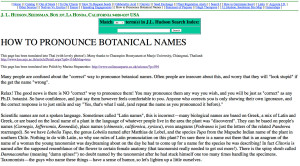Plant identification involves discovering a plant’s name. Common names vary from region to region and person to person. Scientific names are most useful to clearly distinguish a plant from another plant which may have the same common name. Although it is possible that a plant’s scientific name may change — due to newer genetic research or for another reason — the scientific name is usually easy to trace through field guides and floras.
 For a thorough, easy-to-read description of the format of a plant’s scientific name, visit vplants.org (A Virtual Herbarium of the Chicago Region). In addition to the genus and species names, the website page explains the use of subspecific epithets and authors.
For a thorough, easy-to-read description of the format of a plant’s scientific name, visit vplants.org (A Virtual Herbarium of the Chicago Region). In addition to the genus and species names, the website page explains the use of subspecific epithets and authors.
 This resource translates Latin and Greek words into an English equivalent. It was designed for zoology students and therefore it includes words which may not apply in the botanical world.
This resource translates Latin and Greek words into an English equivalent. It was designed for zoology students and therefore it includes words which may not apply in the botanical world.
Pronunciation
If you’ve wondered how to pronounce those scientific names or other botanical terms, check out the following resources:
 J.L. Hudson’s article on How to Pronounce Botanical Names encourages using pronunciations which make sense for a person’s primary language and dialect — recognizing that scientific names are not always Latin or Greek in derivation.
J.L. Hudson’s article on How to Pronounce Botanical Names encourages using pronunciations which make sense for a person’s primary language and dialect — recognizing that scientific names are not always Latin or Greek in derivation.
 Fine Gardening’s website includes a list of plant names previously featured in their magazine. When you click on the name, you can hear it pronounced.
Fine Gardening’s website includes a list of plant names previously featured in their magazine. When you click on the name, you can hear it pronounced.
 Dave’s Garden provides a “botanary.” Click on a chosen word and read about the origin of the word along with a description of how to pronounce it.
Dave’s Garden provides a “botanary.” Click on a chosen word and read about the origin of the word along with a description of how to pronounce it.
